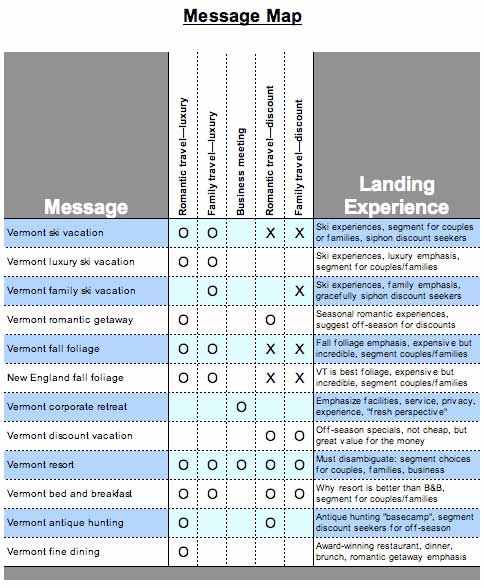But first, let’s set the stage.
Message Match, the Long Tail, and Segmentation
We believe that message match is the foundation of great post-click marketing. Message match means that when someone clicks on one of your ads—one that sets expectations for them, explicitly or implicitly—the landing page they receive fulfills those expectations. This is also called clickthrough continuity.
For example, if you search for “discount Vermont vacations” and you click on an ad that talks about family-friendly getaways, then you expect the landing page you arrive at to present you with discounted family vacation content. That’s message match. If the page you land on is geared towards luxury romantic holidays instead, no discounts in sight, you feel cheated or confused—and move on to the next advertiser. That disconnect is message mismatch, and when it happens, it wastes your ad dollars, wastes your audience’s time, and damages your brand. Unfortunately, message mismatch happens a lot, especially in search marketing.
We’re also advocates of long tail strategies in online marketing: the more specific your message is to particular target audiences, the more effectively you will convert them. Instead of trying to optimize a generic one-size-fits-all message, embrace the diversity of your market with tailored, authentic conversations to each niche.
Essentially this boils down to three things:
- place specific, intentional ads
- fulfill those expectations with specific, intentional landing pages
- understand the audience segments responding to them and disambiguate when necessary
So, how do you organize your online marketing to achieve this? This is where a message map can help.
Message Match Message Map
A message map is a table that relates: messages being advertised, the landing experiences those ads drive traffic to and the audience segments connected between the two. Here’s a sample message map we can walk through:

For example, imagine that we’re doing online marketing for a resort in Vermont. We’re a luxury property, expensive during peak ski season and fall foliage, but we have discount offers in the off-seasons. We cater to both families and romantic getaways, with separate lodging areas for each. We have an award-winning restaurant, and we also host corporate retreats.
Down the left column of the message map, we list very specific advertising messages that we intend to run. These are generally equivalent to target keywords or keyword phrases in search marketing, although the execution of these ideas may be done in display ads or email marketing as well. Here we have message such as:
- Vermont ski vacation
- Vermont romantic getaway
- Vermont fall foliage
Each of these messages may have many variants. “Vermont ski vacation” might include keyword buys or creative executions for “VT skiing,” “ski holiday in Vermont," “Vermont ski resort,"
etc. Those variations are tactical though. Here in the strategic message map, they all roll up to a single message.
Down the right column of the message map, we describe the content focus for the corresponding landing pages. Every message in the left column has a matching landing experience focus. For instance, the message “Vermont antique hunting” will have a landing experience that focuses on using the resort as a basecamp for the niche of antique collectors who scavenger Vermont each year.
Again, the execution of these landing experiences is left as a tactical mission, e.g., testing different layouts, headlines, images, offers, etc. Our goal with the message map is to simply have strategic clarity about the post-click focus for each message that garners clickthroughs.
The heart of the message map is the columns of audience segments that connect messages with landing experiences. These are the identifiable groups of people you’re trying to reach — some people call these personas, although I think a segmentation emphasis is more strategic. Generally, it’s better if these segments are mutually exclusive and collectively exhaustive — at least for any segment that you’re seriously concerned with — but that rule can be bent.
In our Vermont resort example, let’s say their primary audience segments are:
- Romantic travel—luxury
- Family travel—luxury
- Business meeting organizers
- Romantic travel—discount
- Family travel—discount
Now, when connecting messages to landing experiences, simply put an “O” in each segment column whose audience is likely to respond to ads with that message. If a segment isn’t likely to respond, leave that column blank.
If a segment might respond, but is likely to be disappointed with what you have to offer, put an “X” in the column. These are people that you want to handle carefully, because even though you can’t give them what they want in the context of that particular message, you do want their business in other contexts.
Some messages might appeal to only one segment (e.g., “Vermont fine dining”). Others might appeal to all your segments (e.g., “Vermont resort”). The important thing to keep in mind here is that those segments are not the same as messages. A particular audience segment might respond to different messages at different times, and vice versa, a given message might attract more than one audience segment.
When you have more than one audience segment responding to the same message, it’s often helpful to segment them on the landing experience. Conversion paths are often highly effective in these scenarios.
Conclusion
Once you’ve put a message match message map together, you’ve got a shared game plan that everyone involved in the tactical execution of online advertising and landing experiences can work from. It helps prevent messages, audience segments, or landing experiences from getting lost in the cracks or wandering off track from your overall online marketing strategy.




